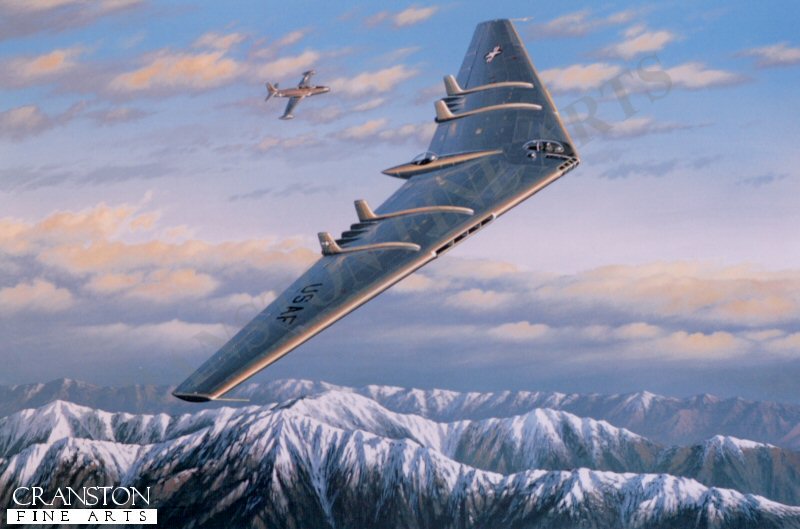- Sku:
- Vendor: Military Aviation Art Prints
Jacks Unusual Design by Stan Stokes. (C)
John K. Jack Northrop was one of the pioneers in American aircraft design and production. He was the chief designer for Lockheed, developing that companys first aircraft, the Vega. In 1939 he formed his own aircraft company. Jacks passion was the tail-less aircraft, or flying wing, a concept he supported passionately. The B-2 bomber of today exhibits many of the design attributes which were pioneered by Jack Northrop in many of his ill-fated, but highly-charged forays in the world of the flying wing. The N1-M was a small flying wing prototype which Northrop demonstrated in 1940-41. The N-9M was built in several different versions to test out some design concepts for Jacks ultimate goal, development of the long-range B-35 flying wing bomber. Northrop eventually succeeded in winning an initial government contract to develop the very large B-35 Flying Wing. This 172 foot wingspan aircraft with a takeoff weight in excess of eighty tons, was conceived by Northrop as the ultimate long range strategic bomber. With a design objective of having a 10,000 mile range with a 10,000 pound bomb load, the B-35 would be a true intercontinental bomber. Under the command of Northrops test pilot Max R. Stanley, the prototype aircraft exhibited a range of 7,500 miles at a cruising speed of 240-MPH. One of the most unusual-looking aircraft ever developed, the XB-35 was powered by four large piston engines powering counter rotating propellers mounted in the pusher position on the aft portion of the wing. The program was plagued with more than its fair share of problems, and it became clear that the design needed to be modified to a jet powered aircraft. Only fifteen of the piston powered aircraft were built, although at one point during the project 200 were on order. The YB-49 was the jet-powered evolution of the B-35 program, and B-35 airframes were modified to take the jet engines. Three prototypes were ultimately produced utilizing the modified B-35 airframes. The YB-49 was powered by eight Allison jet engines, and was capable of a top speed of more than 490-MPH. With a cruising speed of roughly 420-MPH, the jet-powered flying wing had a range of more than 3,000 miles. Northrops Chief Test Pilot Max Stanley piloted the YB-49 on its maiden flight on September 29, 1947, and worked with the B-49 until it was turned over to the Air Force in October of 1947. The slim silhouette of the B-49 provided a small radar target, and during tests off the California coat, the B-49 was able to penetrate air space without being picked up by radar. As depicted in Stan Stokes painting, which is dedicated to the memory of Jack Northrop and his passion for the tail-less aircraft, the B-49 is put through its paces over the mountains surrounding Edwards Air Force Base in California by USAF Chief Test Pilot Major Robert Cardenas. Cardenas flew the B-49 from December of 1947 until May of 1948. He was then scheduled to go back to school, but after one B-49 crashed in June of 1948, he was called back to continue flight tests. Cardenas, who retired from the Air Force as a Brigadier General, flew the B-49 from California to Washington, D.C. in February of 1949. While in Washington, President Truman toured the aircraft, and then requested a tree-top fly-by of the B-49 down Pennsylvania Avenue. Several weeks later Cardenas received a 35mm photo taken by a tourist of the B-49 passing just over the Capitol Building. The annonymous sender could not stand the pressure of having a picture of the Air Forces latest top secret space plane.
Signed by YB-49 Test Pilots Gen Robert Cardenas and Max Stanley.
Prints from the 225 prints from the signed limited edition of 4750 prints, with signature of Stan Stokes and pilots.
Image size 16 inches x 11.5 inches (41cm x 30cm)
Have a question?

Jacks Unusual Design by Stan Stokes. (C)


